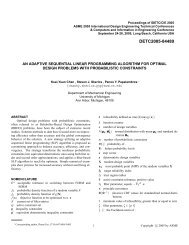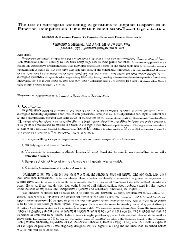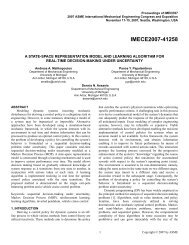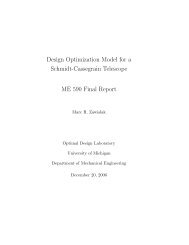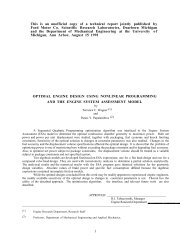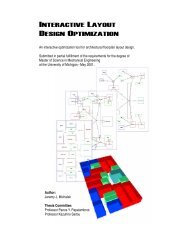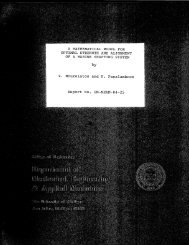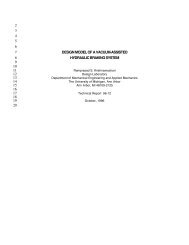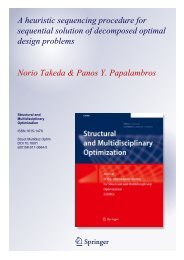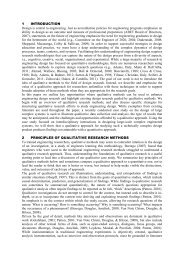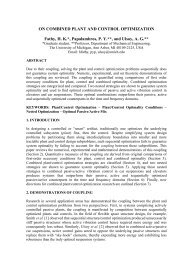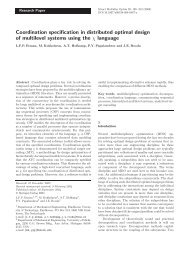Decomposition Analysis of an Automotive Powertrain Design ...
Decomposition Analysis of an Automotive Powertrain Design ...
Decomposition Analysis of an Automotive Powertrain Design ...
You also want an ePaper? Increase the reach of your titles
YUMPU automatically turns print PDFs into web optimized ePapers that Google loves.
epresentation facilitates decomposition <strong>of</strong> NLP problems <strong>an</strong>d MDO optimization problems<br />
because <strong>of</strong> a subtle but import<strong>an</strong>t distinction - no precedence relationships among variables are<br />
specified a priori. In MDO problems, a directed graph is <strong>of</strong>ten used to partition the sequence <strong>of</strong><br />
<strong>an</strong>alysis tasks based on precedence relationships specified prior to partitioning (for example,<br />
Rogers 1989, Rogers <strong>an</strong>d Bloebaum 1994, Altus et al. 1995). Directed graphs are not readily<br />
amenable to representing the NLP problem because the precedence relationships they require do<br />
not exist in <strong>an</strong> NLP problem until after the problem is solved. Only then are dependent <strong>an</strong>d<br />
independent variables distinguished. Hence, we contend that model-based decomposition<br />
facilitates identification <strong>of</strong> broader set <strong>of</strong> coordination strategies for a given problem - those found<br />
in the NLP literature <strong>an</strong>d those found in the MDO literature.<br />
Model-based decomposition proceeds with the four phases shown in Figure 1: model<br />
development, partitioning, coordination strategy development, <strong>an</strong>d, solution. If the objective<br />
function is identified prior to the partitioning process, we use decomposition <strong>an</strong>alysis (Wagner op<br />
cit.) because <strong>an</strong> optimal design problem (ODP) is constructed <strong>an</strong>d <strong>an</strong>alyzed for decomposability.<br />
If the objective is selected after partitioning, such that a decomposable optimization problem is<br />
synthesized, we use decomposition synthesis (Krishnamachari 1996).<br />
Model development consists <strong>of</strong> formulating the system model by defining variables,<br />
parameters, functional relationships, <strong>an</strong>d constraints, <strong>an</strong>d by tr<strong>an</strong>slating desirable defining<br />
properties into partition metrics which define what linking properties are sought (variables vs.<br />
functions), the maximum <strong>an</strong>d minimum number <strong>of</strong> linking properties, the minimum number <strong>of</strong><br />
subproblems desired, the relative bal<strong>an</strong>ce <strong>of</strong> subproblems, <strong>an</strong>d <strong>an</strong>y a priori preferences such as<br />
including a specific variable as a linking variable. Wagner (op cit.) classifies in detail defining<br />
properties for a broad class <strong>of</strong> NLP <strong>an</strong>d MDO decomposition methods.<br />
The partitioning process consists first <strong>of</strong> constructing the functional dependence table<br />
(FDT) <strong>of</strong> the NLP problem which is <strong>an</strong> incidence matrix <strong>of</strong> Boole<strong>an</strong>s denoting whether a function<br />
is dependent on a variable. The undirected graph representation is then constructed <strong>an</strong>d the optimal



